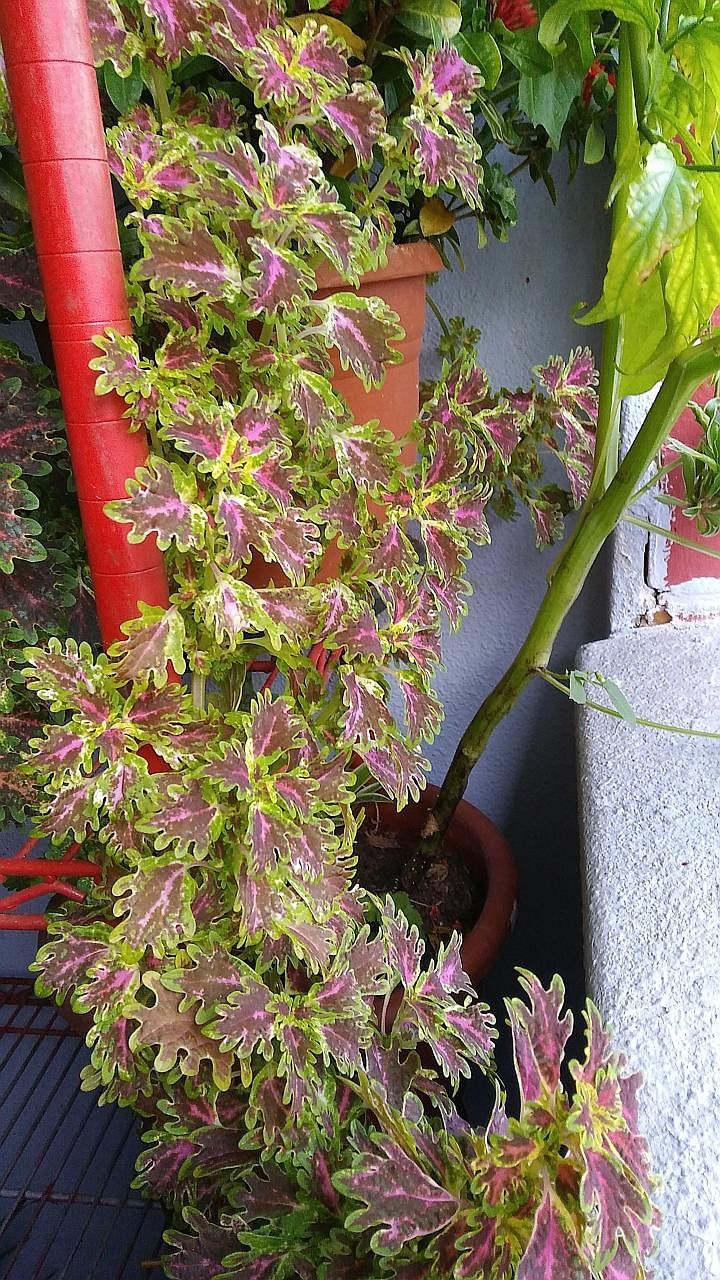Light green dots on leaves caused by citrus Hindu mites
The leaves on my curry leaf plant have many light green dots. They are not aphids or mealy bugs because they do not disappear after I scrape at or scratch the dots. They also seem to be beneath the surface of the leaves. The condition affects my orange jasmine plant too. What is the cause of this and how can I get rid of the light green spots?
Mah Yoke Yoong
The curry leaf plant is infested by a pest called citrus Hindu mite (Schizotetranychus hindustanicus).
The mites also infest related citrus species. They suck sap and cause the rather uniform silver mottling on affected leaves, which will not recover even after treatment.
Research on how to control this pest is still ongoing.
Preventive spraying of environment-friendly pesticides, such as summer oil or soap, may help control the pest population.
African Hosta needs more light

I salvaged this plant from my office when it was not doing too well. It is thriving now and seems to be relatively easy to grow. What is its name and how do I propagate it?
Augustine Heng
The plant is commonly known as the African Hosta. Its botanical name is Drimiopsis maculata (synonym Ledebouria petiolata).
Your plant seems to look a little etiolated, where the leaf stalks are long and stretched, indicating a lack of light.
Under optimal light conditions (filtered sunlight for four to six hours), the plant will adopt a more compact growth habit where the leaf stalks are shorter.
You can propagate the plant via division. The soil should be well-drained to avoid rotting of the plant.
Lantana is an ornamental, but toxic plant

Is this the wild pepper plant (Daun Kaduk)? I found it growing by the road in the Portsdown area. It smells peppery and has small clusters of fruit that look like green peppercorn. The serrated edges of the leaf make it look like the shiso leaf.
Chris Seah
The plant is commonly known as the Shrub Verbena or Lantana. Its botanical name is Lantana camara.
It is a common ornamental plant valued for its colourful, nectar-rich flowers, which are used to attract butterflies. It has escaped cultivation and often appears in wastelands and the edge of some forests here.
Although medicinal, this plant is reported to be toxic to humans and animals. Avoid ingesting it.
Daun Kaduk, also known as Wild Pepper, is botanically known as Piper sarmentosum. Do look up reputable resources on what it looks like. It is a common, native, groundcover plant that is now widely grown in shaded environments. It may also be confused with the Betel Leaf (Piper betle).
Many different plants may look similar to the untrained eye, so it is important to learn more about a plant via its botanical name before consuming it.
Coleus cultivars thrive under different conditions

I used to buy potted plants with colourful leaves. This particular plant grows very well even with only a few hours of morning sunlight on the balcony. But it has not flowered. I have not given it any fertiliser and the transplanted colours are very different. What is the name of this plant and why are the colours so different?
Thong Liew Kee
The plant is a Coleus and its botanical name is Plectranthus scutellarioides. Numerous, highly ornamental cultivars exist and they vary in their leaf shapes and colours.
In general, this plant does better under good light for a good show of its foliage colours.
Some cultivars do very well under full sun while others require semi-shade. For some cultivars, a change in light intensity will lead to a change in the leaf colours, often fading to less vivid hues.
These plants are easily propagated from stem-cuttings and they root easily in water. They require good air circulation and moist, well-drained soils to thrive.
Overly wet soil and excessive shade will quickly lead to disease and subsequent decline of the plant.
Lichens on branches are harmless

My mum's pomegranate tree has a green substance on the branches. The tree is grown outdoors and gets plenty of sunshine. Is the tree sick and how do I get rid of the green substance?
Tan Bee Kay
The greenish patches on the branches of your pomegranate plant are lichens. A lichen is a composite organism made up of an algae or cyanobacteria and fungi in a symbiotic relationship. Their presence indicates a moist environment that is free from harmful pollutants.
Lichens have been regarded as bio-indicators for the environment and they do no harm to the host, in this case, the pomegranate plant. If it bothers you, you can scrape the lichen away gently from the branches by using, say, a toothbrush.
A chemical fungicide can be used to kill the lichen, but its application may not be necessary and will pollute the environment of the garden.
• Answers by Dr Wilson Wong, a certified practising horticulturist and founder of Green Culture Singapore (www.greenculturesg.com). He is also an NParks-certified park manager.
• Have a gardening query? E-mail it with clear, high-resolution pictures of at least 1MB, if any, and your full name to stlife@sph.com.sg

